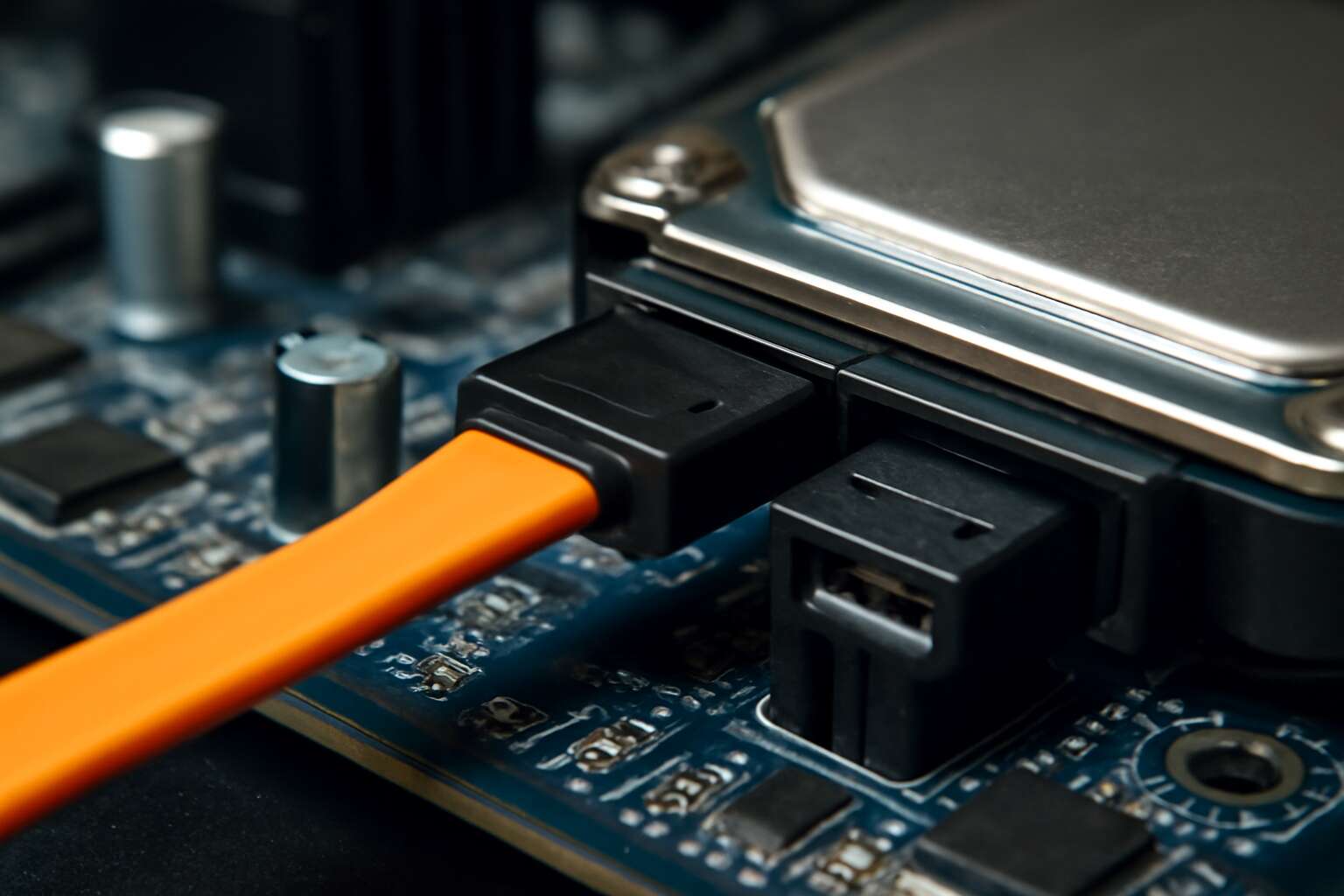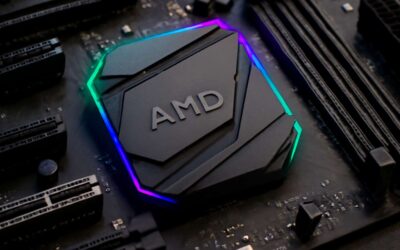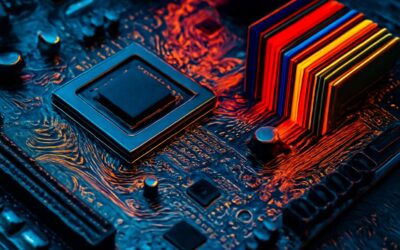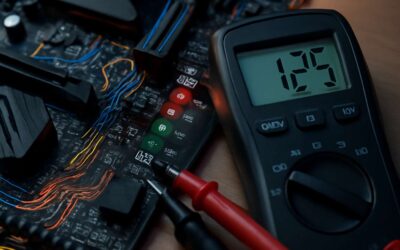Understanding Motherboard to Hard Drive Cables
Types of Cables Connecting Motherboard and Hard Drive – SATA cables, PATA (IDE) cables, and NVMe connectors
In the intricate web of modern computing, understanding the motherboard to hard drive cable is crucial for optimal performance. These cables are the lifelines that connect your storage devices to the motherboard, ensuring data flows seamlessly. Interestingly, the landscape of these cables is diverse, each designed for specific types of drives and speed requirements.
Among the most common are SATA cables, which have become the standard for connecting hard drives and SSDs in most systems today. Their compact design and high data transfer rates make them indispensable. PATA, or IDE cables, belong to an older generation but still find relevance in legacy systems, offering a different pin configuration and data handling method. Meanwhile, NVMe connectors, utilizing M.2 slots, are the new frontier—delivering lightning-fast transfer speeds essential for high-performance computing.
- SATA cables for modern SSDs and hard drives
- PATA (IDE) cables for legacy systems
- NVMe connectors for cutting-edge storage solutions
Importance of Correct Cable Selection – Ensuring compatibility, performance, and data transfer stability
In the realm of modern computing, the importance of selecting the right motherboard to hard drive cable cannot be overstated. A high-quality cable ensures that data transfer remains stable, fast, and reliable—crucial factors in maintaining peak system performance. When choosing the correct cable, compatibility becomes the foundation upon which everything else is built. An incompatible cable can cause bottlenecks, data corruption, or even hardware failure, turning an otherwise seamless operation into a nightmare.
Understanding the nuances of various cables—be it SATA, PATA, or NVMe—is vital. Each has unique specifications designed for specific storage solutions. For instance, a SATA cable’s high transfer rate makes it perfect for SSDs, while legacy systems might require a PATA (IDE) cable. For bleeding-edge performance, NVMe connectors offer unprecedented speeds, but only if paired with the correct motherboard to hard drive cable. It’s not just about connection; it’s about ensuring the entire data transfer ecosystem functions flawlessly, protecting your investment and your productivity.
Types of Hard Drives and Their Connection Interfaces
SATA Hard Drives – Features, advantages, and cable requirements
In the symphony of digital data, the motherboard to hard drive cable acts as the vital conduit, whispering life into your storage devices. Among the various connection interfaces, SATA hard drives reign supreme in modern systems, their sleek cables weaving seamlessly into the fabric of your computer’s core. These cables are more than mere connectors; they are the arteries that pulse with the rhythm of your data’s journey. Designed for swift, stable transfers, SATA cables boast features like hot-swapping and backward compatibility, ensuring your setup remains both versatile and resilient.
Understanding the nuances of these cables reveals their true power. Unlike older PATA (IDE) cables that resemble tangled vines, SATA cables are slender, flexible, and optimized for clarity and speed. They typically require a dedicated motherboard to hard drive cable that features a 7-pin connector on both ends, making installation straightforward yet critical for peak performance. Whether upgrading or building anew, choosing the correct motherboard to hard drive cable is essential to unlocking the full potential of your storage system. After all, a well-chosen cable elevates your data transfer experience from mundane to magnificent!
IDE (PATA) Drives – Legacy support and cable details
While modern storage solutions often steal the spotlight with their blazing NVMe speeds and sleek SATA connections, legacy systems still rely on the sturdy, time-tested IDE (PATA) drives. These drives, once the backbone of personal computers, are now a nostalgic reminder of an era where data transfer was a slower, more deliberate affair. Yet, understanding their connection interfaces remains crucial, especially when maintaining or upgrading older hardware in South Africa’s diverse tech landscape.
The motherboard to hard drive cable for IDE drives is markedly different from its SATA counterpart. Traditionally, these cables are wide, flat ribbon-like structures featuring 40 or 80 pins, which can seem almost labyrinthine to the uninitiated. The cable’s design facilitates parallel data transfer, but it’s less efficient than modern serial connections. Still, for legacy support, IDE cables are indispensable, especially when dealing with vintage equipment or data recovery projects.
In cases where compatibility is key, it’s important to recognize that the connector on the motherboard and the drive itself must match the IDE interface specifications. Here’s a quick rundown of what to look for:
- Compatibility with older motherboards that feature IDE headers
- Availability of 40-pin or 80-pin ribbon cables for optimal performance and shielding
- Ensuring the cable length does not impede airflow or access within the case
Although these cables are largely obsolete in contemporary systems, understanding their specifications and proper connection methods can be vital. Whether you’re restoring a vintage computer or managing legacy storage, the motherboard to hard drive cable for IDE drives remains a crucial component—preserving the history of data transfer technology with resilience and clarity.
NVMe SSDs – Direct motherboard connection via M.2 or PCIe cables
NVMe SSDs have revolutionized data storage with their lightning-fast speeds and minimal latency, but their connection to the motherboard to hard drive cable is unlike traditional drives. These drives connect directly to the motherboard via M.2 slots or PCIe cables, bypassing the need for bulky cables and offering a sleek, efficient pathway for data transfer. This direct connection ensures that performance remains uncompromised, making NVMe SSDs the go-to choice for high-performance systems in South Africa’s demanding tech landscape.
Unlike SATA or PATA drives, which rely on specific cables, NVMe drives leverage the motherboard’s high-speed interfaces. The motherboard to hard drive cable isn’t used here; instead, the connection is embedded directly into the motherboard or via PCIe expansion cards. This setup delivers unparalleled data transfer speeds, often exceeding 3,500 MB/s, a feat impossible with older cable-based systems. For those seeking cutting-edge performance, understanding this difference is essential to optimize system capabilities.
- Motherboards equipped with M.2 slots provide a direct, compact connection for NVMe SSDs, eliminating the need for traditional cables.
- PCIe cables extend this connection into more versatile configurations, accommodating larger or more advanced SSDs.
- Ensuring compatibility between the motherboard’s interface and the NVMe drive is crucial for seamless performance.
SAS Drives – Server-grade connections and cabling considerations
SAS drives represent a robust solution for enterprise-level storage, especially within South Africa’s demanding data environments. Unlike SATA or PATA drives, SAS (Serial Attached SCSI) drives utilize server-grade connections designed for high reliability and sustained performance. These drives rely on specialized motherboard to hard drive cables that can handle the rigorous data transfer requirements of data centers and high-performance servers.
Connection considerations for SAS drives are crucial. They typically require a dedicated SAS controller card, which connects to the drives via high-quality motherboard to hard drive cables. These cables are engineered to support full-duplex communication and offer shielding against electromagnetic interference, ensuring data integrity over long distances. When setting up SAS drives, paying attention to cable quality and compatibility reduces bottlenecks and enhances overall system stability.
- Ensure the motherboard has compatible SAS ports or a dedicated SAS controller card.
- Choose cables that support the data transfer speeds specified by the SAS standard, often up to 12 Gbps.
- Verify that the motherboard to hard drive cable connections are secure to prevent data loss or corruption.
Selecting the Right Motherboard to Hard Drive Cable
Compatibility with Motherboard Interfaces – Checking port types and connector compatibility
Ensuring seamless communication between your motherboard and hard drive begins with verifying the compatibility of your motherboard to hard drive cable. In a world where data flows like an unending river, selecting the correct cable tailored to your motherboard’s interface is paramount. The port types on your motherboard—be it SATA, PATA, or NVMe—dictate the specific cable required for optimal performance.
Understanding these interfaces is akin to deciphering a secret language: SATA ports typically demand slender, flat cables, while PATA connectors require wider, ribbon-like cables. NVMe drives often connect directly via M.2 or PCIe cables, bypassing traditional connectors altogether.
Checking the connector compatibility ensures not only the stability of data transfer but also preserves the longevity of your storage devices. For example, a motherboard to hard drive cable designed for SATA will not fit or function correctly with an NVMe M.2 slot.
For clarity, here’s an overview of common interface types and their respective cables:
- SATA cables for hard drives and SSDs
- PATA (IDE) cables for legacy drives
- NVMe M.2 or PCIe cables for high-speed SSDs
Matching the right cable to your motherboard’s port type is the first step in building a reliable, high-performance computing system.
Length and Shielding – Choosing appropriate cable length and shielding for optimal performance
Choosing the right motherboard to hard drive cable isn’t just about compatibility; it’s about safeguarding your data’s integrity in a landscape riddled with digital hazards. The length of your cable can make or break your system’s performance—too long, and you risk signal degradation; too short, and you’ll struggle with installation. Opting for a cable that strikes the perfect balance ensures a seamless connection, minimizing electromagnetic interference and preserving data stability.
Shielding plays a crucial role in this high-stakes game. A well-shielded motherboard to hard drive cable acts as a barrier against external electromagnetic noise, which can corrupt data or slow transfer speeds. When selecting a cable, consider those with braided or ferrite core shielding to enhance performance and longevity. Remember, in a world where data is as precious as gold, the quality of your cabling could be the difference between a crash and a flawless operation.
Data Transfer Speed Requirements – Matching cable specifications to performance needs
When it comes to maximizing data transfer speed, selecting the right motherboard to hard drive cable is crucial. Not all cables are created equal, and choosing one that matches your performance needs can make the difference between a sluggish system and blazing-fast data flow.
High-performance cables, such as those designed for NVMe SSDs, often feature advanced specifications that support higher transfer rates—sometimes up to several gigabytes per second. Ensuring your motherboard to hard drive cable aligns with these speeds prevents bottlenecks that can sabotage your system’s efficiency.
For demanding applications, consider cables with reinforced shielding and high-quality connectors. These features safeguard against electromagnetic interference, maintaining data integrity during rapid transfers. Remember, a cable that is too slow or incompatible with your motherboard interface could turn your high-speed drive into a bottleneck, stifling your system’s true potential.
Installation and Connection Tips
Proper Cable Handling – Avoiding bending and damage
Handling a motherboard to hard drive cable with care is crucial to avoid costly damage and ensure optimal performance. These cables are delicate, and improper handling can lead to bent pins or broken connectors. When installing, always hold the cable by its connector, not the cable itself, to prevent unnecessary strain. It’s also vital to avoid bending the cable sharply or twisting it excessively, as this can compromise data transfer integrity. Proper cable management doesn’t just look tidy—it protects your hardware and maintains signal quality.
When connecting a motherboard to hard drive cable, double-check port alignment before plugging in. If the cable feels snug or resistant, don’t force it. Instead, gently reseat the connector, ensuring it clicks securely into place. For longer-term durability, consider using cable clips or ties to keep the cable flat and out of the way of moving parts. This not only prevents accidental disconnection but also minimizes electromagnetic interference, which can degrade data transfer speeds. Remember, a well-handled cable is key to a stable, high-performance system!
Secure Connections – Ensuring firm attachment without forcing connectors
Ensuring a firm and secure connection between your motherboard and hard drive cable is essential for system stability. A loose or improperly seated cable can cause intermittent data transfer issues, which are often mistaken for more serious hardware failures. When connecting, never force the connector into the port; if resistance is felt, gently reseat the cable and ensure it clicks into place. This simple step prevents damage to delicate pins or connectors, saving you costly repairs down the line.
For added peace of mind, consider using cable management accessories like clips or ties. These help keep the motherboard to hard drive cable flat and out of the way of moving parts, reducing the risk of disconnection or electromagnetic interference. Remember, a properly secured cable not only safeguards your hardware but also maintains optimal data transfer speeds, contributing to a more reliable and high-performing computer system. Proper installation techniques are the backbone of a durable, efficient setup—don’t overlook their importance!
Cable Management – Organizing cables for airflow and maintenance
In the labyrinthine realm of modern computing, the meticulous orchestration of cables often dictates the harmony between performance and longevity. A well-organized motherboard to hard drive cable can be the subtle difference between a system that hums seamlessly and one beset by erratic data flow. Behind the scenes, these seemingly innocuous connections form the backbone of data integrity and system stability, yet their importance is often undervalued.
Thoughtful cable management is essential—not merely for aesthetics but to foster optimal airflow and simplify maintenance. Tangles and clutter can obscure crucial connections, increase heat, and complicate future upgrades. To prevent this, consider employing cable clips or ties; these accessories keep the motherboard to hard drive cable flat and secure, avoiding interference with fans or other moving parts. When routing cables, always respect the natural bend radius, ensuring you don’t bend or twist delicate wires, which could compromise signal quality or cause damage over time.
For a streamlined setup, an ordered approach can be invaluable.
- Identify the correct connector type for your motherboard and hard drive—be it SATA, PATA, or NVMe—and verify compatibility beforehand.
- Measure the necessary length to reach without excess slack, reducing clutter and electromagnetic interference.
This thoughtful planning ensures the motherboard to hard drive cable remains unobtrusive yet accessible, safeguarding your data’s transit while maintaining a tidy workspace.
Troubleshooting and Testing Your Hard Drive Connection
Common Connection Issues – Loose cables, incompatible ports
In the intricate dance of data flow, even the slightest misstep can cause a cascade of problems. When troubleshooting your motherboard to hard drive cable connection, the first culprits are often deceptively simple: loose cables or incompatible ports. A secure connection is vital; a few millimeters can mean the difference between seamless operation and frustrating errors. If your hard drive isn’t recognized or data transfer seems sluggish, inspecting the cable connection should be your initial move.
Sometimes, the issue isn’t just about tightness but compatibility. For example, using a SATA cable with an incompatible port or a PATA cable on a modern motherboard can cause silent failures. To diagnose, follow this sequence:
- Verify the cable is firmly seated at both ends.
- Check that the motherboard to hard drive cable matches the port specifications.
- Look for visible damage or bent pins on connectors.
Careful testing and visual inspection often reveal the root of connection issues, preventing hours of troubleshooting and ensuring your data’s integrity remains intact. Remember, a well-handled cable and proper connection can make all the difference in maintaining peak performance of your system.
Performance Testing – Using diagnostic tools and BIOS/OS checks
When troubleshooting your motherboard to hard drive cable, performance testing becomes an essential step. Even a seemingly flawless connection can hide underlying issues that sabotage data flow. Using diagnostic tools or BIOS/OS checks, you can unveil these hidden faults and restore your system’s integrity. Many users overlook the importance of verifying transfer speeds, which can reveal if the cable is bottlenecking performance or if there’s a silent failure lurking in the shadows.
To get accurate results, start by running a disk health check or a speed test. These tests can highlight sluggish data transfer rates or read/write errors that signal a faulty motherboard to hard drive cable. If you notice inconsistencies, inspect the cable visually for damage or pin misalignment. Remember, a well-tested connection isn’t just about speed; it’s about safeguarding your valuable data from silent corruption or loss.
Implementing a methodical approach—such as following an ordered sequence of testing—can save hours of frustration.
- Verify cable seating at both ends
- Check for visible damage or bent pins
- Run diagnostic utilities for performance benchmarks
—ensures you’re covering all bases and maintaining the highest standards for your system’s reliability. When it comes to motherboard to hard drive cable, thorough testing isn’t optional; it’s the key to unlocking peak performance and peace of mind.
Replacing Faulty Cables – Identifying signs of cable failure and solutions
In the labyrinth of digital infrastructure, a single faulty connection can obscure the true health of a system, much like a silent but deadly toxin. When troubleshooting your motherboard to hard drive cable, the first signs of failure often manifest subtly—sporadic data corruption, unrecognized drives, or inexplicable boot errors. These symptoms are whispers from the machine, hinting that something more insidious lurks beneath the surface. Recognizing these signs early is vital; a compromised cable can silently sabotage data transfer speeds and destabilize entire workflows.
Visual inspection remains an essential initial step. Look for any visible damage—bent pins, frayed insulation, or corrosion—that could impair the connection. Sometimes, the remedy is as simple as reseating the cable or replacing a worn-out component. When in doubt, diagnostic tools and BIOS/OS performance checks can provide a clearer picture. Running a thorough disk health check or speed test often reveals sluggish transfer rates or read/write errors, both indicative of underlying cable failure. Remember, ensuring secure, firm connections at both ends is crucial—don’t force a connector, but do verify that it is seated correctly and snugly to prevent intermittent contact.
In some cases, the motherboard to hard drive cable itself becomes the culprit.
- Loosened or damaged cables
- Pin misalignment
- Incompatible or low-quality cables
can all contribute to intermittent failures or complete disconnects. Replacing faulty cables with high-quality, compatible alternatives often restores stability and performance. When selecting a replacement, consider the length, shielding, and data transfer specifications to meet your system’s demands, especially if high-speed SSDs or large data transfers are involved. The process is meticulous, but the payoff—reliable, efficient data flow—is well worth the effort.
Future Trends in Motherboard to Hard Drive Connectivity
Emergence of NVMe and M.2 Interfaces – Advantages over traditional cables
In the ever-evolving landscape of data storage, the future of motherboard to hard drive cable connectivity is more than just a technological upgrade—it’s a philosophical shift. The emergence of NVMe and M.2 interfaces exemplifies this transition, offering a glimpse into a world where speed and efficiency redefine our expectations. Unlike traditional cables, these interfaces leverage direct motherboard connections that bypass many of the limitations inherent in older standards.
This evolution isn’t merely about faster data transfer; it’s about unlocking a new realm of possibilities. With NVMe SSDs connecting via M.2 slots, the reliance on bulky cables diminishes, giving way to sleek, compact, and high-performance solutions. These advancements promise not just enhanced speeds but also more streamlined cable management—an often-overlooked aspect that affects airflow and maintenance. As technology progresses, the role of the motherboard to hard drive cable will continue to morph, emphasizing minimalism, reliability, and a deeper integration of hardware components.
USB and Thunderbolt External Drives – Connecting external hard drives with modern cables
As technology accelerates at a dizzying pace, the future of motherboard to hard drive cable connectivity promises a fascinating blend of sophistication and minimalism. USB and Thunderbolt external drives are rapidly becoming the preferred choice for those who crave both speed and convenience, especially in the South African tech landscape where versatility is king. These modern cables are designed to transmit data at lightning-fast speeds, making cumbersome internal cables seem almost archaic.
Looking ahead, the trend leans toward seamless integration, where external drives connect effortlessly via USB-C or Thunderbolt ports—eliminating the need for traditional motherboard to hard drive cables. Instead, these interfaces leverage high-bandwidth protocols to ensure data transfer is both swift and stable. As manufacturers refine these connectors, expect more streamlined setups that prioritize ease of use and aesthetic minimalism. Such developments not only enhance performance but also contribute to better cable management, reducing clutter and improving airflow inside the case.
In essence, the evolution of motherboard to hard drive cable connections is shifting toward external, high-speed interfaces that embody the modern ethos of simplicity and efficiency. Whether it’s through USB or Thunderbolt, these advancements are reshaping how we think about connecting storage devices—favoring sleek, high-performance solutions that are as reliable as they are elegant. After all, in a world obsessed with speed, who wants tangled cables that threaten both performance and patience? Certainly not the discerning South African tech enthusiast.
Wireless Storage Solutions – Potential impact on traditional cabling
As technology continues to evolve at an unprecedented pace, the future of motherboard to hard drive cable connectivity promises a paradigm shift that could redefine data management. Wireless storage solutions are emerging as a compelling alternative, with innovations like Wi-Fi 6, Bluetooth 5.2, and even emerging standards such as Wi-Fi 7 offering high-speed data transfer without the constraints of traditional cables. This transition could significantly impact how we perceive the role of a motherboard to hard drive cable, especially in the South African tech landscape where mobility and flexibility are highly valued.
Imagine a world where external storage devices communicate seamlessly with the motherboard, bypassing physical cables altogether. Such advancements could lead to a decline in the necessity for traditional motherboard to hard drive cables, making internal wiring less cluttered and more aesthetically minimalist. The potential for wireless storage solutions to deliver comparable or even superior performance to wired connections is increasingly tangible, driven by high-bandwidth protocols and low latency technologies.
While wired connections like SATA cables and NVMe connectors remain dominant for their reliability and speed, the social and technological implications of wireless storage are profound. They could democratize access to high-capacity storage, especially in regions where cable management is a challenge or where upgrading internal components is less feasible. The integration of these wireless interfaces with motherboard systems could foster a new era of flexible, clutter-free computing environments that prioritize both performance and elegance.
Ultimately, the evolution toward wireless storage solutions hints at a future where traditional motherboard to hard drive cable setups become a thing of the past—a shift driven by innovation, societal needs, and the relentless pursuit of simplicity in design. As connectivity standards advance, the landscape of data transfer will become more intuitive and accessible, transforming the very fabric of digital interaction for users across South Africa and beyond.




0 Comments